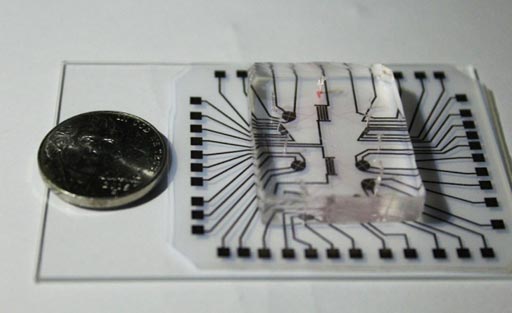Inexpensive Diagnostic Device May Revolutionize Medical Care
By LabMedica International staff writers
Posted on 28 Feb 2017
A radically designed “lab on a chip” diagnostic device is expected to dramatically reduce the cost of isolating and characterizing rare cells and molecules, a process that is of critical importance in diagnosis of common lethal diseases such as malaria, tuberculosis, HIV, and cancer.Posted on 28 Feb 2017
Point-of-care diagnostics in the developing world and resource-limited areas require numerous special design considerations to provide effective early detection of disease. Of particular need for these contexts are diagnostic technologies featuring low costs, ease of use, and broad applicability. Investigators at Stanford University recently described a nanoparticle-inkjet-printable microfluidics-based platform that fulfilled these criteria and that is expected to significantly reduce the footprint, complexity, and cost of clinical diagnostics. This reusable 0.01 USD device is miniaturized to handle small sample volumes and can perform numerous analyses.

Image: The lab-on-a-chip comprises a clear silicone microfluidic chamber for housing cells and a reusable electronic strip — a flexible sheet of polyester with commercially available conductive nanoparticle ink (Photo courtesy of Zahra Koochak, Stanford University).
The device is a combination of microfluidics, electronics, and inkjet printing technology. It is in essence a two-part system: a clear silicone microfluidic chamber for housing cells resting on top of a reusable electronic strip. A regular inkjet printer was used to print the electronic strip onto a flexible sheet of polyester using commercially available conductive nanoparticle ink.
The device, which separates cells based on their size and intrinsic electrical properties, can perform label-free and rapid single-cell capture, efficient cellular manipulation, rare-cell isolation and selective analytical separation of biological species, sorting, concentration, positioning, enumeration, and characterization. The miniaturized format allows for small sample and reagent volumes. By keeping the electronics separate from microfluidic chips, the former can be reused and device lifetime is extended.
The process of manufacturing the device is significantly less expensive, time-consuming, and complex than traditional lab-on-a-chip platforms, requiring only an inkjet printer rather than skilled personnel and clean-room facilities. Production requires only about 20 minutes (versus up to weeks) and one US cent - an unprecedented cost in in clinical diagnostics.
“The genome project has changed the way an awful lot of medicine is done, and we want to continue that with all sorts of other technology that are just really inexpensive and accessible,” said senior author Dr. Ronald W. Davis, professor of biochemistry and genetics at Stanford University. “The motivation was really how to export technology and how to decrease the cost of things.”
A study describing the technology was published in the February 6, 2017, online edition of the journal Proceedings of the [U.S.] National Academy of Sciences.













